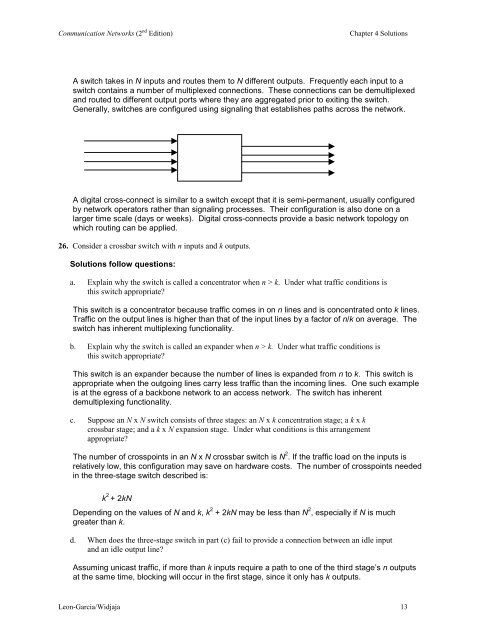Solutions to Chapter 4 - Communication Networks
Solutions to Chapter 4 - Communication Networks
Solutions to Chapter 4 - Communication Networks
You also want an ePaper? Increase the reach of your titles
YUMPU automatically turns print PDFs into web optimized ePapers that Google loves.
<strong>Communication</strong> <strong>Networks</strong> (2 nd Edition)<br />
<strong>Chapter</strong> 4 <strong>Solutions</strong><br />
A switch takes in N inputs and routes them <strong>to</strong> N different outputs. Frequently each input <strong>to</strong> a<br />
switch contains a number of multiplexed connections. These connections can be demultiplexed<br />
and routed <strong>to</strong> different output ports where they are aggregated prior <strong>to</strong> exiting the switch.<br />
Generally, switches are configured using signaling that establishes paths across the network.<br />
A digital cross-connect is similar <strong>to</strong> a switch except that it is semi-permanent, usually configured<br />
by network opera<strong>to</strong>rs rather than signaling processes. Their configuration is also done on a<br />
larger time scale (days or weeks). Digital cross-connects provide a basic network <strong>to</strong>pology on<br />
which routing can be applied.<br />
26. Consider a crossbar switch with n inputs and k outputs.<br />
<strong>Solutions</strong> follow questions:<br />
a. Explain why the switch is called a concentra<strong>to</strong>r when n > k. Under what traffic conditions is<br />
this switch appropriate<br />
This switch is a concentra<strong>to</strong>r because traffic comes in on n lines and is concentrated on<strong>to</strong> k lines.<br />
Traffic on the output lines is higher than that of the input lines by a fac<strong>to</strong>r of n/k on average. The<br />
switch has inherent multiplexing functionality.<br />
b. Explain why the switch is called an expander when n > k. Under what traffic conditions is<br />
this switch appropriate<br />
This switch is an expander because the number of lines is expanded from n <strong>to</strong> k. This switch is<br />
appropriate when the outgoing lines carry less traffic than the incoming lines. One such example<br />
is at the egress of a backbone network <strong>to</strong> an access network. The switch has inherent<br />
demultiplexing functionality.<br />
c. Suppose an N x N switch consists of three stages: an N x k concentration stage; a k x k<br />
crossbar stage; and a k x N expansion stage. Under what conditions is this arrangement<br />
appropriate<br />
The number of crosspoints in an N x N crossbar switch is N 2 . If the traffic load on the inputs is<br />
relatively low, this configuration may save on hardware costs. The number of crosspoints needed<br />
in the three-stage switch described is:<br />
k 2 + 2kN<br />
Depending on the values of N and k, k 2 + 2kN may be less than N 2 , especially if N is much<br />
greater than k.<br />
d. When does the three-stage switch in part (c) fail <strong>to</strong> provide a connection between an idle input<br />
and an idle output line<br />
Assuming unicast traffic, if more than k inputs require a path <strong>to</strong> one of the third stage’s n outputs<br />
at the same time, blocking will occur in the first stage, since it only has k outputs.<br />
Leon-Garcia/Widjaja 13







